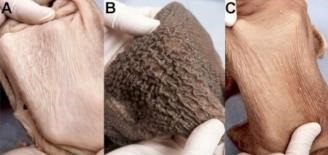
Comparison of rumen papillae development at 6 weeks in calves fed milk only (A), milk and grain (B), or milk and hay (C). Note the marked differences in papillae length and color. Source: Penn State Extension
A second argument for feeding hay revolves around the type of starter that is being fed. While there are limited studies comparing which is best, if starters are fresh, free from dust and mold, and are readily available, calves tend to do well on either kind. However, particle size of starter ingredients plays a key role in whether hay is necessary. To form a calf pellet, very small particle sizes of grains are used and bound together. The smaller the particle size of starter ingredients, the faster the starch will ferment in the rumen, potentially resulting in ruminal acidosis. Incorporating hay into a diet like this will help to buffer the rumen, slowing the rate of digestion. Starch is more readily available in pelleted starters because of the manufacturing process. However, in textured starters, calves must chew the ingredients to break down the available starch. Calves eating texturized starter will be at a lower risk for acidosis and can be on a non-forage diet for a longer period than calves fed a pelleted starter (Jones and Heinrichs, 2017). Therefore, if calf starters consist of small particles, including too many fines because of sorting, hay should be included into the calf diet to prevent acidosis.
In a 2019 study published in the Journal of Dairy Science, Engleking et al. studied calves that were offered either a textured starter and chopped hay separately or a starter mixed with the chopped hay. In the preweaning phase, there were no differences in intakes or average daily gains (ADG’s). Similar results were seen at weaning, with the only difference being calves on the hay and grain mix experienced a decrease in feed efficiency. However, during the post weaning phase, calves consuming the hay and grain mix experienced decreased dry matter intake as well as lower average daily gains. Engelking et al (2019) concluded that because calves eating the starter mixed with hay consumed more hay because their ration was a mixture, rather than a choice. This resulted in quicker gut fill and calves feeling full, thus decreasing intake amounts and subsequently gains. Also post weaning, the calves that could choose between grain and hay consumed more grain than they did hay. It was hypothesized that as the milk source was removed from the diet, calves were choosing to fill that nutritional void by consuming a more energy rich source feed the calf grain. The group of calves on the mix ration tried to consume higher amounts of grain as well, however because the hay was mixed in the ration, hay was also consumed while trying to find more grain particles. Therefore, if hay is going to be included in the ration for calves, it is important to provide it separately from the calf starter, so calves are not limited in grain intake as their nutritional sources change.
Research done at the University of Florida focused on the behavioral, development, and performance of group-housed dairy calves when offered hay. Horvath and Miller-Cushon (2019) studied groups of calves on automated calf feeders being fed a pelleted starter. Some groups were offered a low-quality chopped grass hay as a separate source of feed. Feed intakes and calf weights were measured regularly, along with monitoring behavior trends. The results of the study showed an increase in smaller, more frequent feeding bouts in the groups of calves being offered hay. There were also fewer unrewarded trips to the automated feeders in the hay groups, indicating that calves were more satisfied than those not eating hay. Calves in the hay groups also showed less pen-directed sucking during the weaning period, meaning they possibly redirected their oral behavior from sucking on pen fixtures or pen mates to spending time consuming hay. The research used a low-quality hay to provide a sensory experience more so than offering a more appealing high-quality hay that would encourage intakes and create gut fill in the calves, limiting starter intake.
Because there are so many factors that should be considered, incorporating hay into the diets of dairy calves can be a hard decision. There are clearly arguments for both sides of the issue. Therefore, the decision must be made based on the management practices of the calf and heifer program for the specific farm. Should hay be fed to your calves, well it depends.
Source : psu.edu